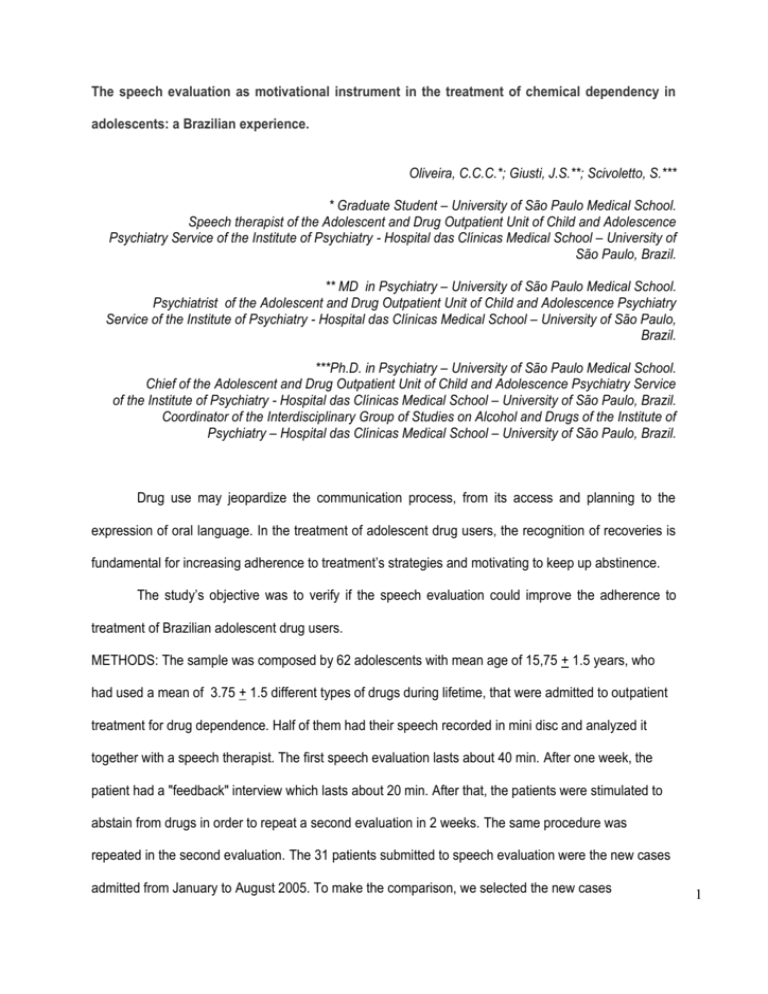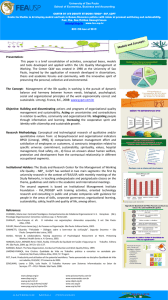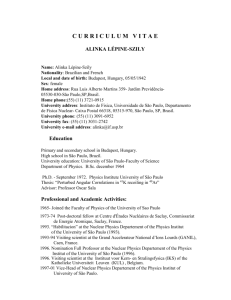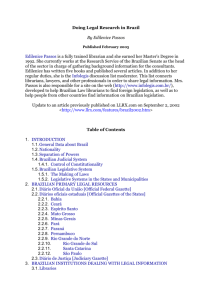O próprio discurso como instrumento na - Folha de S.Paulo
advertisement

The speech evaluation as motivational instrument in the treatment of chemical dependency in adolescents: a Brazilian experience. Oliveira, C.C.C.*; Giusti, J.S.**; Scivoletto, S.*** * Graduate Student – University of São Paulo Medical School. Speech therapist of the Adolescent and Drug Outpatient Unit of Child and Adolescence Psychiatry Service of the Institute of Psychiatry - Hospital das Clínicas Medical School – University of São Paulo, Brazil. ** MD in Psychiatry – University of São Paulo Medical School. Psychiatrist of the Adolescent and Drug Outpatient Unit of Child and Adolescence Psychiatry Service of the Institute of Psychiatry - Hospital das Clínicas Medical School – University of São Paulo, Brazil. ***Ph.D. in Psychiatry – University of São Paulo Medical School. Chief of the Adolescent and Drug Outpatient Unit of Child and Adolescence Psychiatry Service of the Institute of Psychiatry - Hospital das Clínicas Medical School – University of São Paulo, Brazil. Coordinator of the Interdisciplinary Group of Studies on Alcohol and Drugs of the Institute of Psychiatry – Hospital das Clínicas Medical School – University of São Paulo, Brazil. Drug use may jeopardize the communication process, from its access and planning to the expression of oral language. In the treatment of adolescent drug users, the recognition of recoveries is fundamental for increasing adherence to treatment’s strategies and motivating to keep up abstinence. The study’s objective was to verify if the speech evaluation could improve the adherence to treatment of Brazilian adolescent drug users. METHODS: The sample was composed by 62 adolescents with mean age of 15,75 + 1.5 years, who had used a mean of 3.75 + 1.5 different types of drugs during lifetime, that were admitted to outpatient treatment for drug dependence. Half of them had their speech recorded in mini disc and analyzed it together with a speech therapist. The first speech evaluation lasts about 40 min. After one week, the patient had a "feedback" interview which lasts about 20 min. After that, the patients were stimulated to abstain from drugs in order to repeat a second evaluation in 2 weeks. The same procedure was repeated in the second evaluation. The 31 patients submitted to speech evaluation were the new cases admitted from January to August 2005. To make the comparison, we selected the new cases 1 consecutively admitted from end of 2000 until may/2001, respecting the proportion male/female of the first group. The inclusion criteria for the treatment program were: aged 10 to 17, living in the Great São Paulo, assigned the informed consent. Adolescents with diagnosis of mental retardation, schizophrenic syndromes, according to the DSM-IV criteria or those who needed hospitalization were excluded from the study. The first 4 weeks of the treatment program consisted of we called diagnosis procedure: 4 individual assessments with an adolescent psychiatrist (45 min each), 2 family interview made by a family therapist (90 min each), KID-SADS evaluation (90-120 min), physical evaluation and laboratory exams. After that, the treatment consisted of weekly individual therapy with psychiatrist (45 min each), weekly family group orientation (90 min) and a monthly appointment for the patient and at least one family member (60 min), in order to evaluate the outcomes. This program was absolutely the same for both groups excepted for the speech evaluation which was performed at the first day of the patient at the program. Comorbidity, permanence in treatment and duration of abstinence were between the two groups. RESULTS: All youths had a diagnostic of substance use dependence (SUD). Current psychiatric diagnoses other than SUD was present in 32% of the total sample (43% of females and 29% of males, p>0.05), without differences between the two groups. In the group with speech evaluation, 4 (13%) had current diagnosis of major depression disorder (MDD), 1 (4%) conduct disorder (CD) and 6 (19.5%) attention deficit and hyperactivity disorders (ADHD). In the group without speech evaluation, 10 (32%) had MDD, 2 (6.5%) CD, and 3 (10%) ADHD. Major depression disorder was significantly more frequently among females (p=0.005). Adolescents who were submitted to speech evaluation stayed longer in treatment comparing to those who were not (30 ± 19.5 weeks vs. 13 ± 11.5 weeks, p=0,023, respectively). Considering those who had used mainly marijuana during the year before the interview, adolescents with speech evaluation were able to abstain from marijuana longer periods than those without it (17 ± 14 weeks vs. 6 ± 7.5 weeks, p=0.01, respectively). No differences were found among other drugs users. 2 DISCUSSION: The clinical impression was that the speech recorded in mini disc and presented to the patients could make it possible for them to recognize and reflect on the alterations objectively verified, associating them to the use of drugs, particularly to marijuana. After that, the patients would be more stimulated to abstain from drugs in order to repeat a second speech evaluation. In the cases that the second evaluation had showed a significant improvement in the speech, the patient seemed to become more motivated to come for appointments and to keep up abstinence. Besides that, some of them might have an improvement on relationships obtained by the improvement of their speech and language. These improvements might also be reflected on a better performance on social and scholastic demands, increasing their motivation to keep adhered to treatment and to follow the treatment’s orientations. However, we have to consider the study’s limitations: it was not a random study, which might have some influence in the outcome. Also, it’s not known whether the group without speech evaluation had some speech pathology or not. Attending the patients’ needs is one of the most important points to consider when analyzing adherence to treatment. Speech evaluation was an interesting resource for motivating the chemical dependent adolescents to keep on treatment, especially those addicted to marijuana who usually are more resistant to the idea of abstinence. Finding clinical and therapeutic resources to motivate the adolescent to treat himself/herself is one of the biggest professional challenges for those who deal with adolescents. References: OLIVEIRA, C.C.C.; SCIVOLETTO, S. Percepción de los efectos del alcohol y otras drogas en el habla y el lenguaje en consumidores habituales en edad adulta. Revista de Logopedia, Foniatria y Audiologia, Barcelona, Espanha, v. 24, no. 3, pages 126-131, 2004. CROFT, R. J.; MACKAY, A. J.; MILLS, A. T.; GRUZELIER, J. G .The relative contributions of ecstasy and cannabis to cognitive impairment. Psychopharmacology, 153 (3):373-379, 2001. O'LEARY, D.S.; BLOCK, R.I.; KOEPPEL, J.A.; FLAUM, M.; SCHULTZ, S.K.; ANDREASEN, N.C.; PONTO, L.B.; WATKINS, G.L.; HURTIN, R.R.; HICHWA, R.D. Effects of smoking marijuana on brain perfusion and cognition. Neuropsychopharmacology; 26 (6):802-16, 2002. 3 O'LEARY, D.S.; BLOCK, R.I.; TURNER, B.M.; KOEPPEL, J.; MAGNOTTA, V.A.; PONTO, L.B.; WATKINS, G.L.; HICHWA, R.D.; ANDREASEN, N.C. Marijuana alters the human cerebellar clock. Neuroreport; 14(8):1145-51, 2003. GROTENHERMEN, F. Pharmacology of cannabinoids. Neuro Endocrinol Lett; 25(1-2):14-23, 2004. PERKINS, W.; KENT, R. D.; CURLEE, R. F. A theory of neuropsycholinguistic function in Stuttering. Journal Speech Hearing Research, 34: 734-52, 1991. Mailing Address: Sandra Scivoletto, M.D., Ph.D. R. João Moura, 647 conj: 102 Zip code 05412-911 São Paulo-SP BRAZIL E-mail address: sscivole@uol.com.br 4






